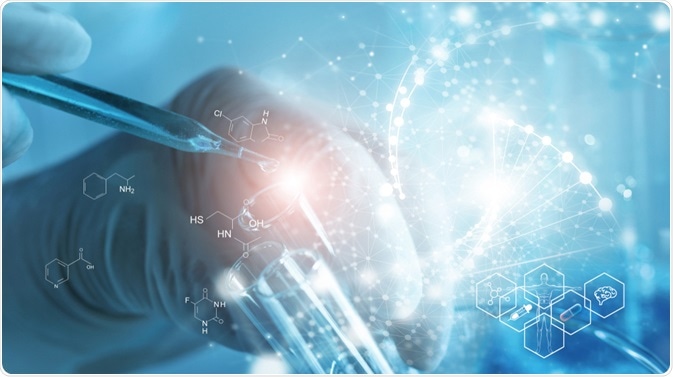Bioorganic chemistry was born out of combining the two well-established scientific disciplines of chemistry and biochemistry. It is a rapidly growing scientific field that focuses on implementing chemical methods in the study of biological processes. While biochemistry is sometimes used interchangeably with bioorganic chemistry, the latter term is more applicable to the field that concentrated on the biological aspects of organic chemistry.
Organic biochemistry searches to expand organic-chemical research (including kinetics, structures, synthesis, to name a few), toward biology. It is used to determine the interactions, reactivity, and structure of organic compounds of biological significance. This is different from biochemistry, which uses chemistry to further our understanding of biological processes. However, there is some overlap between the two with the study of metalloenzymes and cofactors.
Here, we discuss how the field of bioorganic chemistry was established and its modern applications.

Image Credit: PopTika/Shutterstock.com
The beginnings of bioorganic chemistry
In the early nineteenth century, a division of chemistry emerged as scientists became interested in studying the substances they were able to isolate from living organisms. This field, known as organic chemistry, rapidly developed to encompass the study of the chemical transformations, physical properties, reactions, and structures of organic compounds.
By the 1950s, research conducted by organic chemists was generally not interested in biological systems. During this time, in the field of biology, however, scientists had become focused on the behaviors of biological organisms and their morphologies. While today we understand that the interpretation of biological activities at the level of the molecule is vital to gaining a comprehensive understanding of any biological system, this idea was still in its infancy in the mid-twentieth century.
As this idea became more established, the lines between biology and chemistry began to blur, and the discipline of modern bioorganic chemistry, which depends on insights from both biology and chemistry, was born.
Modern applications of bioorganic chemistry
Today, research projects often call for biologists and chemists to work side by side. Scientific investigation regularly requires the adoption of techniques from both biology and chemistry. For example, the discovery of potential new therapeutic targets requires chemical analysis of newly sequenced genomes to identify previously unexplored biologically active molecules. Biologists are then required to determine which of these molecules may play a role in regulating signaling events and are implicated in cellular interactions.
The design of man-made molecules is another example of a new field of research that requires the collaboration of biologists and chemists. As well as working on identifying previously undiscovered biological compounds with potential therapeutic activity, scientists are also focused on designing their own therapeutic molecules with specific properties. To design these synthetic molecules, organic chemists utilize biological assays to inform their design, helping them build molecules that bind accurately to target molecules.
Further to this, a collaboration between biologists and chemists is needed to facilitate research into nanoparticles. Nanoparticles have unique properties, in comparison with their bulk form counterparts. These unique properties are due to the particles’ small size. In recent years, scientists have discovered that the special properties of nanoparticles can be leveraged into a variety of applications, spanning the fields of medical science, clean energy, materials science, food safety, transportation, environmental science, and security, to name a few.
The field of nanoscience is relatively new and scientists are still exploring the potential uses of nanoparticles. For nanoscience to reach its full potential, it relies greatly on bioorganic chemistry to reveal the behavior of molecules at the nanoscale. Biologists work with chemists to establish the structures and mechanisms of nanoparticles and to determine how they interact with other molecules and catalyze reactions. Without bioorganic chemistry, this research would not be able to take place.
Bioorganic chemistry is also leveraged in the vital research that is revealing more about nucleic acid chemistry, giving us a deeper understanding of DNA and the many roles played by nucleic acids. Research has shown that nucleic acids act as enzymes, ribosomes, receptors, and regularities of genetic expression.
As our knowledge of the natural DNA system deepens, scientists have increasingly sought to enhance the natural nucleic acid-based supramolecular assemblies of genetic information to generate new properties via chemical modification or the attachment of other molecules. Bioorganic chemistry allows this research to happen. Without the collaboration of both disciplines, our knowledge of DNA and nucleic acid chemistry would be far less rich.
Finally, bioorganic chemistry has also been used to explore the roles of carbohydrates and peptides, as well as deepen our knowledge on activities such as molecular recognition and biosynthesis. In the coming years, we will likely see further significant developments in the field of bioorganic chemistry, as well as the expansion of applications in which it is leveraged.
References:
- Poulter, C., 2009. Bioorganic Chemistry. A Natural Reunion of the Physical and Life Sciences. The Journal of Organic Chemistry, 74(7), pp.2631-2645. https://www.ncbi.nlm.nih.gov/pmc/articles/PMC2680001/
- Northrop, D. and Simpson, F., 1997. New concepts in bioorganic chemistry beyond enzyme kinetics: Direct determination of mechanisms by stopped-flow mass spectrometry. Bioorganic & Medicinal Chemistry, 5(4), pp.641-644. https://www.sciencedirect.com/science/article/abs/pii/S0968089697000205
- Van Vranken, D. and Weiss, G., 2018. Introduction to Bioorganic Chemistry and Chemical Biology. https://www.taylorfrancis.com/books/mono/10.1201/9780203381090/introduction-bioorganic-chemistry-chemical-biology-david-van-vranken-gregory-weiss
Further Reading